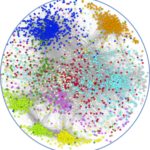Link to Pubmed [PMID] – 20080951
Genes Dev. 2010 Jan;24(2):129-34
Cytoplasmic polyadenylation is a widespread mechanism to regulate mRNA translation that requires two sequences in the 3′ untranslated region (UTR) of vertebrate substrates: the polyadenylation hexanucleotide, and the cytoplasmic polyadenylation element (CPE). Using a cell-free Drosophila system, we show that these signals are not relevant for Toll polyadenylation but, instead, a “polyadenylation region” (PR) is necessary. Competition experiments indicate that PR-mediated polyadenylation is required for viability and is mechanistically distinct from the CPE/hexanucleotide-mediated process. These data indicate that Toll mRNA is polyadenylated by a noncanonical mechanism, and suggest that a novel machinery functions for cytoplasmic polyadenylation during Drosophila embryogenesis.


